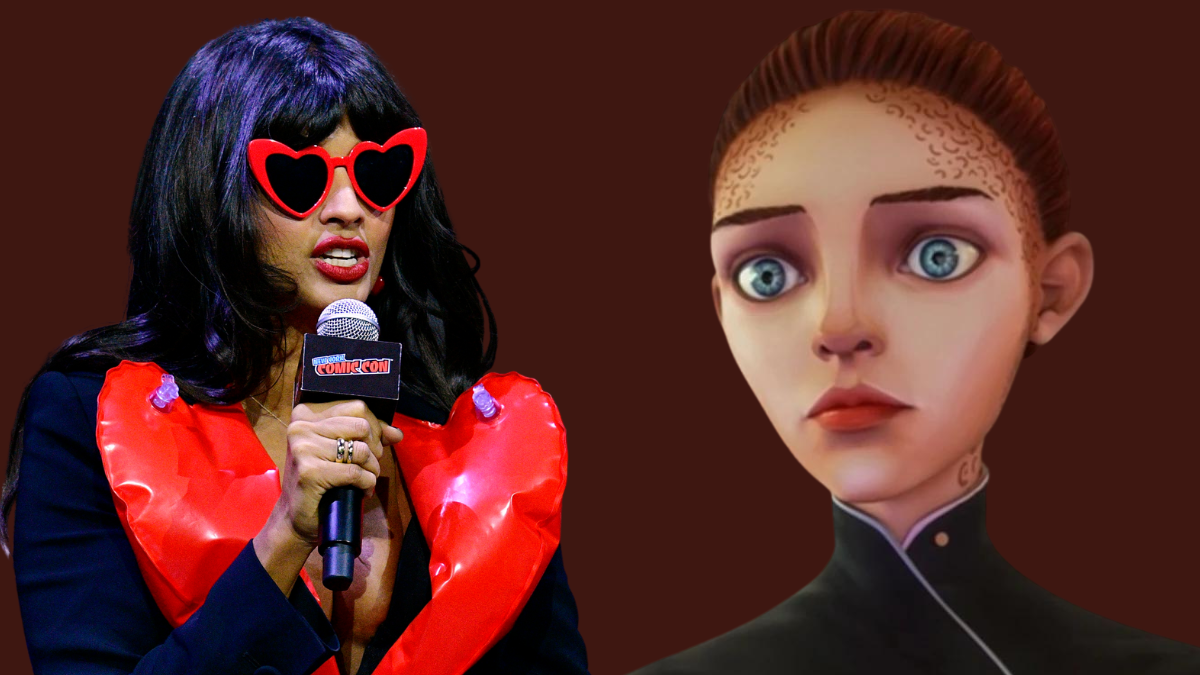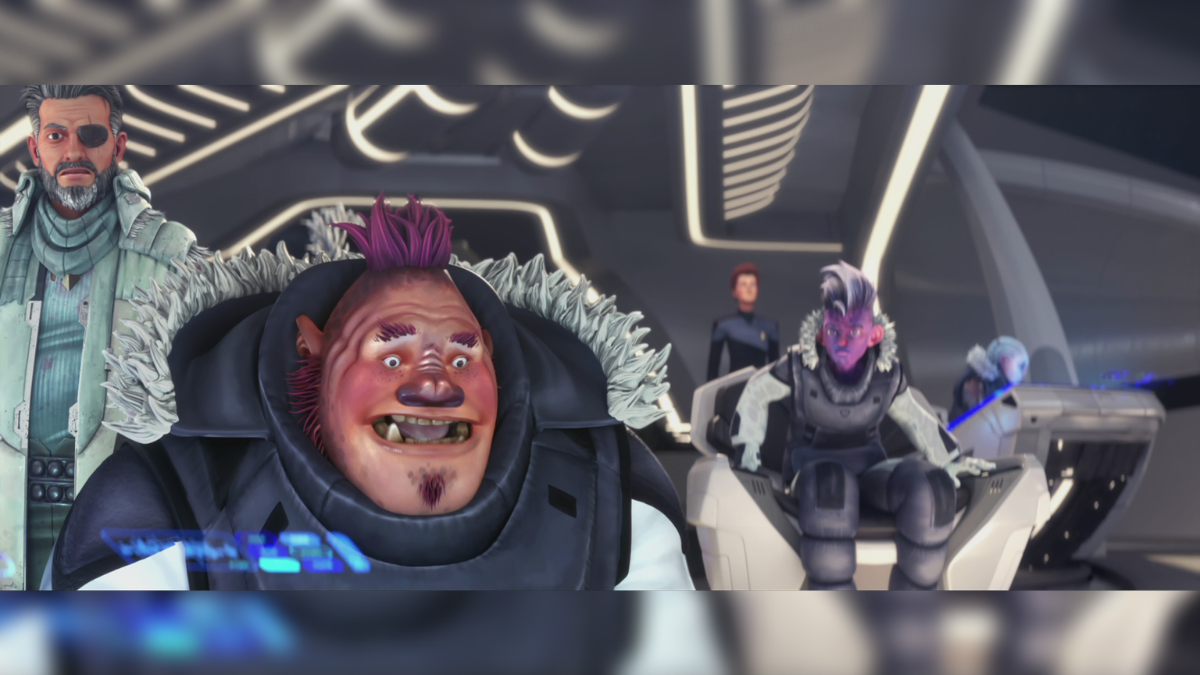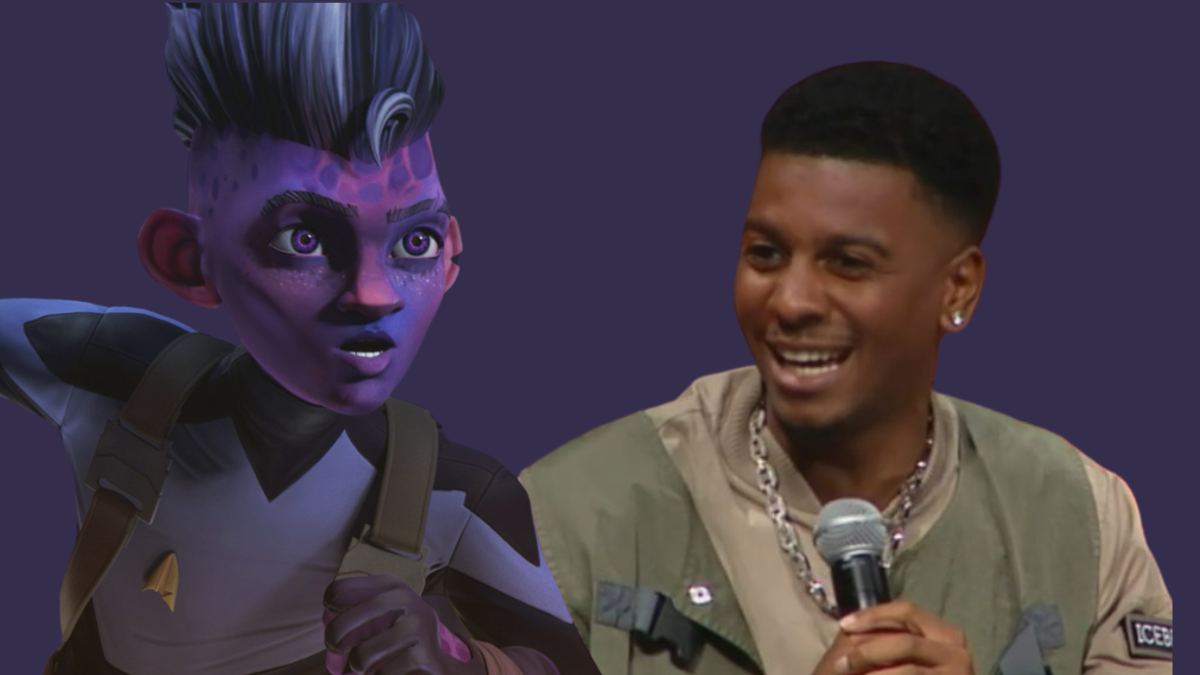NYCC STAR TREK INTERVIEW: Jameela Jamil

Jameela Jamil plays Ensign Asencia in STAR TREK: PRODIGY. Images: Paamount+ / Eugene Gologursky/Getty Images.
DSTN was invited to take part in a press roundtable with the cast and creators of Star Tek: Prodigy at this past weekend’s New York Comic Con. For these roundtables, seven news outlets are put at a table together and given 15 minutes to ask whatever questions they wish, in a “round robin” style. Then the celebrity moves to the next table to be replaced by a new one. This week we’ll be releasing these interviews, one by one. For the most part, each outlet got one question or two, depending on how lengthy the answers were, so not all the questions covered were asked by DSTN.
OCTOBER 14, 2022 - Jameela Jamil is brand new to the Star Trek universe. So new, in fact, that her character, Ensign Asencia, has only been seen once, on the bridge of the USS Dauntless under the command of Vice Admiral Janeway. All we know about her so far is that she’s a Trill, but we’re sure to learn more about her throughout the second half of the season.
Jamil is ebullient by nature, and, as a true Star Trek fan, is living the dream many of us have of actually appearing on one of the shows and cementing her place in Trek lore. She arrived dressed in a long black coat, with a bright red inflatable floaty that began at her lapels and terminated by wrapping around her waist. Her lipstick and heart-shaped sunglasses matched the color of the floaty and behind the large shades were tiny hearts drawn in black on each cheek. “If not Comic Con, then where?” she quipped about wearing the outfit. She confided to us that she had to blow the floaty up herself in the car on the way to the Javitz Center that morning.
On her love of Star Trek:
[I’m a] big Star Trek fan, although I don’t think there’s anyone quite like my character in the franchise, so far. But I’m a big Star Trek fan since I was about 4 or 5 years old. Next Generation was my favorite. Deep Space Nine, also amazing, Voyager, also amazing, but that was my introduction. And also, that was the one we got the most replays of in England, so we would just watch it again and again and again.
I got to meet Patrick Stewart a few years ago. And I heard there’s a Next Generation reunion happening, so I’m going to f****ing lose it. You’re going to see a lot of very weird selfies on the internet.
On whether there’s anything she’d like to do in Star Trek that Asencia doesn’t have the chance to do::
No, I think my character really gets to do all the fun things, just later. You know, I feel very satisfied with this character. I got to play with kind of parts of my brain that I haven’t been able to play with on any script I’ve ever done before. Especially in animation. This has been the most exciting thing I’ve ever done, and I was so excited. I’m very lucky to love all of the things that I do, but it’s such a pump of dopamine to actually think that I get to go in with the Hageman brothers and create this character. And they gave me a lot of liberty to create he with them and let me really play. I’m really proud of her. She develops very fast and very sort of surprisingly.
On Star Trek’s themes:
They were one of the only shows, especially back then, that would talk about race, class, gender, disability, even, with Geordi. Like, there were all different things. Data. Data represented a certain, like, section of society that maybe is socially awkward or feels a bit disconnected. I know that was me as a kid and my brother. And we definitely identified with him and the way that he would try to seek to understand how to feel. I wasn’t very good at communicating like that, and I also used to give too much detail about everything. I was a very excessive kid, and everybody used to tell me, “Shut the f**k up,” too. And watching that happen in a really affectionate way, I think, also taught that generation to be a bit kinder and more affectionate with people who sometimes don’t read the social cues. And it taught me to maybe learn how to read social cues, in fact.
But, yeah, I think that we tell important stories. There’s so much diversity back from the Captain Kirk days. That, to me, is something that’s very exciting and a legacy that no one can match. And also, they’ve been so ahead of the game in the stories that they’ve told. And the stories from 40 years ago are the stories that we still need now, more than ever. Like, people who come from different places, different backgrounds, speak different languages, who don’t even understand each other. Who politically do not agree with each other. Even the journey with, like, the Ferengi. We need to see more stories of people who come from different places finding a way to work together.
I think that’s what The Good Place was also really beautiful with, was people from different places, who have different outlooks coming together to create a better solution, you know? And so maybe it’s that they have common enemies, like the Borg, or whatever, but I think that we just created a very fantastical way to tell actually very grounded stories.
They did, not me. I only just joined. THEY!
On who Asencia is:
Pain in the ass. Everything I’ve ever done, I’m playing a pain in the ass. Pitch Perfect comes out in a month, I’m a pain in the ass. Tahani [The Good Place], THE pain in the ass. Titania [She-Hulk: Attorney at Law], pain in the ass. I enjoy those characters a lot because I think that they’re complicated and complex and I like understanding why they are the way that they are.
But she’s precocious, she’s extremely confident, very empowered, self-empowered, and she’s clever. She’s very bright. And she uses that to her advantage throughout the show, so you’ll see more about that later.
On her approach to delivering Gene Roddenberry’s philosophy to a younger audience:
I don’t [feel like it’s going over children’s heads] because in the Hageman brothers I trust. They’ve written something that is so beautiful that exists on two planes, where it can be understood by kids in one way and understood by adults in a very different way. And like, I was able to read this and it didn’t feel like material that was dumbed down or diluted for me in any way. So I trust them. And having seen how brilliantly executed the first part of season 1 was, I have no concerns whatsoever.
I just thought it was some of the most fun and excellent writing I’ve read in a really long time. I would die if we made this into a live-action series.
On accepting the offer to play Asencia:
It was just an all-caps email. My team could visibly hear me screaming from my fingertips. Yeah, I was thrilled. I didn’t even read the material, I didn’t ask how much money it was, I didn’t ask how much they would need me for or where I would be. I just said “yes” and then I phoned my brother.
On how much she knew about Asencia’s character before starting work:
We needed to establish her. She’s a very strong character, so we needed to make sure we had her down from day one. And it was important for them and me that I understood the journey I was about to go on, and that had to be put into my delivery. So hopefully I’ve executed that. I tried my best.
On the Star Trek fan community:
They wear their hearts on their sleeves, unlike any other community I’ve seen. They’re the kindest community. They really want the best. They’re so welcoming to all of us. Even some of the younger people on the show who haven’t yet experienced a lot of Star Trek, who haven’t grown up on Star Trek. You know, this is their first experience of it. They haven’t been shunned. There’s a lot of snobbery in some fandoms, where it’s just like, “Do you know enough to hang with us?” And I get that, but also, we’re deliberately trying to welcome in young people who haven’t seen any or maybe aren’t old enough to have seen some of the more explicit, older content. And so, I think it’s been incredibly cool to witness a fandom that can be this strong, this global, this long-lasting who still maintain that kindness. And it feels like good teachers, good students, means that the philosophy of the show has clearly worked its way through the fanbase and there is an ultimate kindness and togetherness.
On her Marvel, DC, and Star Tek characters living forever:
It is weird. It’s exciting, though, because this stuff meant so much to me. I didn’t really have friends when I was a kid. I didn’t go out much. I had a pretty solitary childhood, and this stuff was my whole escape. So to ever know that I might be a part of someone else’s escape is truly one of the great privileges. I don’t think by any stretch of the imagination that I’ve saved lives, but I do know that they accidentally kind of saved mine. And so just to be able to be a part of that for someone else feels great.
On what alien species she’d like to meet:
I have a soft spot for Worf. Obviously, Data’s my favorite, and Data’s so unique and amazing. But I have a strong love of Worf. I think he always got a raw deal. No one could see how funny he was and how straight his delivery was. The mating call delivery was one of my favorite lines in the history of Star Trek, and so I have a big love for the Klingons.
I’m also really grumpy. You know, I’m English. So they were deeply relatable to me.
On transitioning from acting on camera to acting with her voice:
It’s harder and easier at the same time. It’s harder because it doesn’t translate as easily across the microphone, so you have to sort of throw much more and you have to be much more exaggerated, and I tend to be a more subtle, soft-spoken person IRL. And so you have to really throw yourself into it. There’s no space for inhibition.
And at the same time, there are no things around you that are going to make you feel intimidated. You don’t have cameras in your face, you don’t have other actors around, you are alone in a booth with two people who couldn’t be rooting for you more. By that I mean, the Hageman brothers. There’s no worrying about what I look like or where the camera is, or if I’m in the right light. I’m just in the character. It’s the most immersive acting experience you can ever have, and I genuinely think it’s made me a better on-camera actor, to learn how to be a voiceover actor.
It’s great training because it means you have to put your vanity, your insecurity…there’s no space for any of that, you know? You have to be pretending to fall off a cliff or be eaten by a dinosaur, some of the ridiculous things that I’ve had to do. You know, all these fake fights that I’ve had to have. And you just have to be fully ridiculous in that role, and it pays off. And that’s what makes some of the great voice actors that are out there.
On the importance of art with a message::
I really am drawn to things that have a message, a great message. I think, you know, with She-Hulk it was very much the story that I was trying to tell was one of female misogyny and how it only ever punishes women for us to look at each other as a threat. My character plays someone who’s so threatened by another woman and women have this scarcity mindset. There’s only room for one, and we must knock each other out. So I think anywhere like that, where I think there is a bigger story to tell, I’m interested and I don’t want to make frivolous things. I have lots of offers for well-paid, silly things that I’m not going to enjoy showing to a young person.
I would personally like to, as much as I can, make things that combine fun and a really strong, resonating message. Because right now, it’s become so impossible to have a political conversation because everything gets heated so fast, and everyone’s so judgemental. And I think art is one of the last ways that we can have these important conversations about class, race, sex, any of these things, where it doesn’t become instantly inflammatory. So they’ll watch the whole episode and you’ll get to the end of your plea or your argument. And I think art is very important in that way.
Monday’s interview: The Hageman brothers (creators) and Ben Hibon (director).
T is the Managing Editor for Daily Star Trek News and a contributing writer for Sherlock Holmes Magazine and a Shakespeare nerd. He may have been the last professional Stage Manager to work with Leonard Nimoy, has worked Off-Broadway and regionally, and is the union Stage Manager for Legacy Theatre, where he is currently working with Julie Andrews. after which he’ll be working on Richard III at Elm Shakespeare Company.




